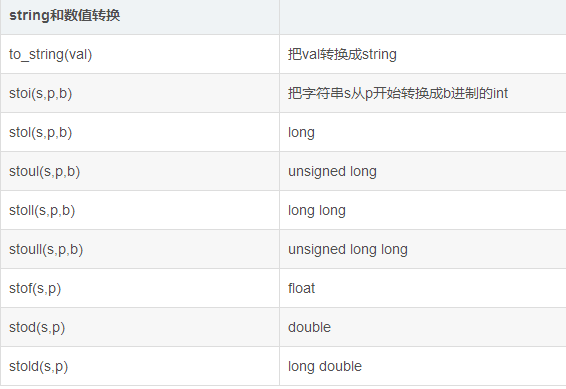string是C++标准库的一个重要的部分,主要用于字符串处理。可以使用输入输出流方式直接进行操作,也可以通过文件等手段进行操作。同时C++的算法库对string也有着很好的支持,而且string还和c语言的字符串之间有着良好的接口。虽然也有一些弊端,但是瑕不掩瑜。
声明和初始化方法:
想使用string首先要在头文件当中加入< string >
声明方式也很简单
声明:
string s;//声明一个string 对象
string ss[10];//声明一个string对象的数组
初始化:
使用等号的初始化叫做拷贝初始化,不使用等号的初始化叫做直接初始化。
#include <bits/stdc++.h> using namespace std; int main() { ios::sync_with_stdio(false); string s;//默认初始化,一个空字符串 string s1("ssss");//s1是字面值“ssss”的副本 string s2(s1);//s2是s1的副本 string s3=s2;//s3是s2的副本 string s4(10,'c');//把s4初始化 string s5="hiya";//拷贝初始化 string s6=string(10,'c');//拷贝初始化,生成一个初始化好的对象,拷贝给s6 //string s(cp,n) char cs[]="12345"; string s7(cs,3);//复制字符串cs的前3个字符到s当中 //string s(s2,pos2) string s8="asac"; string s9(s8,2);//从s2的第二个字符开始拷贝,不能超过s2的size //string s(s2,pos2,len2) string s10="qweqweqweq"; string s11(s10,3,4);//s4是s3从下标3开始4个字符的拷贝,超过s3.size出现未定义 return 0; }
字符串处理:
substr操作:
注意substr没有迭代器作为参数的操作
#include <bits/stdc++.h> using namespace std; int main() { ios::sync_with_stdio(false); string s="abcdefg"; //s.substr(pos1,n)返回字符串位置为pos1后面的n个字符组成的串 string s2=s.substr(1,5);//bcdef //s.substr(pos)//得到一个pos到结尾的串 string s3=s.substr(4);//efg return 0; }
如果输入的位置超过字符的长度,会抛出一个out_of_range的异常
insert操作:
代码来自cpp官网,经过自己的整理
注意用迭代器当参数和无符号数当参数的区别
#include <bits/stdc++.h> using namespace std; int main() { ios::sync_with_stdio(false); string str="to be question"; string str2="the "; string str3="or not to be"; string::iterator it; //s.insert(pos,str)//在s的pos位置插入str str.insert(6,str2); // to be the question //s.insert(pos,str,a,n)在s的pos位置插入str中插入位置a到后面的n个字符 str.insert(6,str3,3,4); // to be not the question //s.insert(pos,cstr,n)//在pos位置插入cstr字符串从开始到后面的n个字符 str.insert(10,"that is cool",8); // to be not that is the question //s.insert(pos,cstr)在s的pos位置插入cstr str.insert(10,"to be "); // to be not to be that is the question //s.insert(pos,n,ch)在s.pos位置上面插入n个ch str.insert(15,1,':'); // to be not to be: that is the question //s.insert(s.it,ch)在s的it指向位置前面插入一个字符ch,返回新插入的位置的迭代器 it = str.insert(str.begin()+5,','); // to be, not to be: that is the question //s.insert(s.it,n,ch)//在s的it所指向位置的前面插入n个ch str.insert (str.end(),3,'.'); // to be, not to be: that is the question... //s.insert(it,str.ita,str.itb)在it所指向的位置的前面插入[ita,itb)的字符串 str.insert (it+2,str3.begin(),str3.begin()+3); // to be, or not to be: that is the question... return 0; }
erase操作:
用来执行删除操作
删除操作有三种
- 指定pos和len,其中pos为为起始位置,pos以及后面len-1个字符串都删除
- 迭代器,删除迭代器指向的字符
迭代器范围,删除这一范围的字符串,范围左闭右开
#include <iostream> #include <string> int main () { std::string str ("This is an example sentence."); std::cout << str << ' '; // "This is an example sentence." str.erase (10,8); // ^^^^^^^^ //直接指定删除的字符串位置第十个后面的8个字符 std::cout << str << ' '; // "This is an sentence." str.erase (str.begin()+9);// ^ //删除迭代器指向的字符 std::cout << str << ' '; // "This is a sentence." // ^^^^^ str.erase (str.begin()+5, str.end()-9); //删除迭代器范围的字符 std::cout << str << ' '; // "This sentence." return 0; }
append和replace操作:
append函数可以用来在字符串的末尾追加字符和字符串。由于string重载了运算符,也可以用+=操作实现
repalce顾名思义,就是替换的意思,先删除,后增加。
代码来自cpp官网,附上自己的解释
#include <iostream> #include <string> int main () { std::string str; std::string str2="Writing "; std::string str3="print 10 and then 5 more"; //直接追加一个str2的字符串 str.append(str2); // "Writing " //后面追加str3第6个字符开始的3个字符串 str.append(str3,6,3); // "10 " //追加字符串形参的前5个字符 str.append("dots are cool",5); // "dots " //直接添加 str.append("here: "); // "here: " //添加10个'.' str.append(10u,'.'); // ".........." //添加str3迭代器范围的字符串 str.append(str3.begin()+8,str3.end()); // " and then 5 more" //最后这个比较特殊,意思是添加5个'A',实际上参数里面的65对应的asc码就是65 str.append<int>(5,65); // "....." //字符串追加也可以用重载运算符实现 str+="lalala"; std::cout << str << ' '; return 0; }
replace的使用方法,replace支持使用无符号整数寻找位置,也支持用迭代器寻找位置
#include <iostream> #include <string> int main () { std::string base="this is a test string."; std::string str2="n example"; std::string str3="sample phrase"; std::string str4="useful."; // replace signatures used in the same order as described above: // Using positions: 0123456789*123456789*12345 std::string str=base; // "this is a test string." //第9个字符以及后面的4个字符被str2代替 str.replace(9,5,str2); // "this is an example string." (1) //第19个字符串以及后面的5个字符用str的第7个字符以及后面的5个字符代替 str.replace(19,6,str3,7,6); // "this is an example phrase." (2) //第8个字符以及后面的9个字符用字符串参数代替 str.replace(8,10,"just a"); // "this is just a phrase." (3) //第8个字符以及后面的5个字符用字符串参数的前7个字符替换 str.replace(8,6,"a shorty",7); // "this is a short phrase." (4) //第22以及后面的0个字符用3个叹号替换 str.replace(22,1,3,'!'); // "this is a short phrase!!!" (5) //迭代器的原理同上 // Using iterators: 0123456789*123456789* str.replace(str.begin(),str.end()-3,str3); // "sample phrase!!!" (1) str.replace(str.begin(),str.begin()+6,"replace"); // "replace phrase!!!" (3) str.replace(str.begin()+8,str.begin()+14,"is coolness",7); // "replace is cool!!!" (4) str.replace(str.begin()+12,str.end()-4,4,'o'); // "replace is cooool!!!" (5) str.replace(str.begin()+11,str.end(),str4.begin(),str4.end());// "replace is useful." (6) std::cout << str << ' '; return 0; }
以上的replace操作可以用insert和erase的操作组合替换,但是replace操作更加方便。
assign操作:
assign操作在一起列容器当中都存在,比如vector等等。是一个很基本的操作函数,string使用assign可以灵活的对其进行赋值。
#include <iostream> #include <string> int main () { std::string str; std::string base="The quick brown fox jumps over a lazy dog."; // used in the same order as described above: //直接把base赋值给str str.assign(base); std::cout << str << ' '; //把base第10个字符以及后面的8个字符赋给str str.assign(base,10,9); std::cout << str << ' '; // "brown fox" //把参数中的0到6个字符串赋给str str.assign("pangrams are cool",7); std::cout << str << ' '; // "pangram" //直接使用参数赋值 str.assign("c-string"); std::cout << str << ' '; // "c-string" //给str赋值10个'*'字符 str.assign(10,'*'); std::cout << str << ' '; // "**********" //赋值是10个'-' str.assign<int>(10,0x2D); std::cout << str << ' '; // "----------" //指定base迭代器范围的字符串 str.assign(base.begin()+16,base.end()-12); std::cout << str << ' '; // "fox jumps over" return 0; }
string的搜索操作:
string类中提供了很多性能优秀,使用方便的成员方法。而且在泛型算法当中也有很多实用的技巧。
find和rfind函数:
find函数主要是查找一个字符串是否在调用的字符串中出现过,大小写敏感。
#include <bits/stdc++.h> using namespace std; int main() { ios::sync_with_stdio(false); std::string str ("There are two needles in this haystack with needles."); std::string str2 ("needle"); // different member versions of find in the same order as above: //在str当中查找第一个出现的needle,找到则返回出现的位置,否则返回结尾 std::size_t found = str.find(str2); if (found!=std::string::npos) std::cout << "first 'needle' found at: " << found << ' '; //在str当中,从第found+1的位置开始查找参数字符串的前6个字符 found=str.find("needles are small",found+1,6); if (found!=std::string::npos) std::cout << "second 'needle' found at: " << found << ' '; //在str当中查找参数中的字符串 found=str.find("haystack"); if (found!=std::string::npos) std::cout << "'haystack' also found at: " << found << ' '; //查找一个字符 found=str.find('.'); if (found!=std::string::npos) std::cout << "Period found at: " << found << ' '; //组合使用,把str2用参数表中的字符串代替 // let's replace the first needle: str.replace(str.find(str2),str2.length(),"preposition"); std::cout << str << ' '; return 0; }
rfind函数就是找最后一个出现的匹配字符串,返回的位置仍然是从前往后数的。
#include <bits/stdc++.h> using namespace std; int main() { ios::sync_with_stdio(false); std::string str ("The sixth sick sheik's sixth sheep's sick."); std::string key ("sixth");// ^ //rfind是找最后一个出现的匹配字符串 std::size_t found = str.rfind(key); if (found!=std::string::npos) { cout<<found<<endl;//输出23 str.replace (found,key.length(),"seventh");//找到的sixth替换成seventh } std::cout << str << ' '; return 0; }
查找的效率非常高,我没看过stl源码剖析,但是感觉是用kmp实现的。呵呵,可以自己写一个。
find_….of函数:
-
- find_first_of(args) 查找args中任何一个字符第一次出现的位置
- find_last_of(args) 最后一个出现的位置
- find_fist_not_of(args) 查找第一个不在args中的字符
- find_last_not_of 查找最后一个不在args中出现的字符
#include <bits/stdc++.h> using namespace std; int main() { ios::sync_with_stdio(false); std::string str1 ("Please, replace the vowels in this sentence by asterisks."); std::size_t found1 = str1.find_first_of("aeiou"); //把所有元音找出来用*代替 while (found1!=std::string::npos) { str1[found1]='*'; found1=str1.find_first_of("aeiou",found1+1); } std::cout << str1 << ' '; //在str2中找到第一个不是消协英文字母和空格的字符 std::string str2 ("look for non-alphabetic characters..."); std::size_t found2 = str2.find_first_not_of("abcdefghijklmnopqrstuvwxyz "); if (found2!=std::string::npos) { std::cout << "The first non-alphabetic character is " << str2[found2]; std::cout << " at position " << found2 << ' '; } return 0; }
find_last_of和find_last_not_of与first基本相同,就不写例子代码
-
比较与转换:
-
类似c语言的字符串比较函数strcmp函数一样,支持字符串比较操作,同时也类似python、C#语言中的函数一样,支持把数字和字符串转换。有些特性是C++11当中才有。
注意编译器bug:
在MinGW编译器当中如果版本低于3.8,虽然支持c++11但是里面有一个bug,就是不支持字符串和数组的转换!要更新MinGW的版本才可以,或者直接使用g++。compare函数:
和strcmp函数一样,如果两个字符串相等,那么返回0,调用对象大于参数返回1,小于返回-1。
在compare当中还支持部分比较,里面有6个参数可以设置。#include <bits/stdc++.h> using namespace std; int main() { ios::sync_with_stdio(false); string s1="123",s2="123"; cout<<s1.compare(s2)<<endl;//0 s1="123",s2="1234"; cout<<s1.compare(s2)<<endl;//-1 s1="1234",s2="123"; cout<<s1.compare(s2)<<endl;//1 std::string str1 ("green apple"); std::string str2 ("red apple"); if (str1.compare(str2) != 0) std::cout << str1 << " is not " << str2 << ' '; //str1的第6个字符以及后面的4个字符和参数比较 if (str1.compare(6,5,"apple") == 0) std::cout << "still, " << str1 << " is an apple "; if (str2.compare(str2.size()-5,5,"apple") == 0) std::cout << "and " << str2 << " is also an apple "; //str1的第6个字符以及后面的4个字符和str2的第4个字符以及后面的4个字符比较 if (str1.compare(6,5,str2,4,5) == 0) std::cout << "therefore, both are apples "; return 0; }
由于string重载了运算符,可以直接用>,<,==来进行比较,也很方便。
数值转换:
在io的部分有过数值和字符串相互转换的例子,使用的是stringstream函数,在c++11当中有定义好的现成的函数取调用,非常方便。
